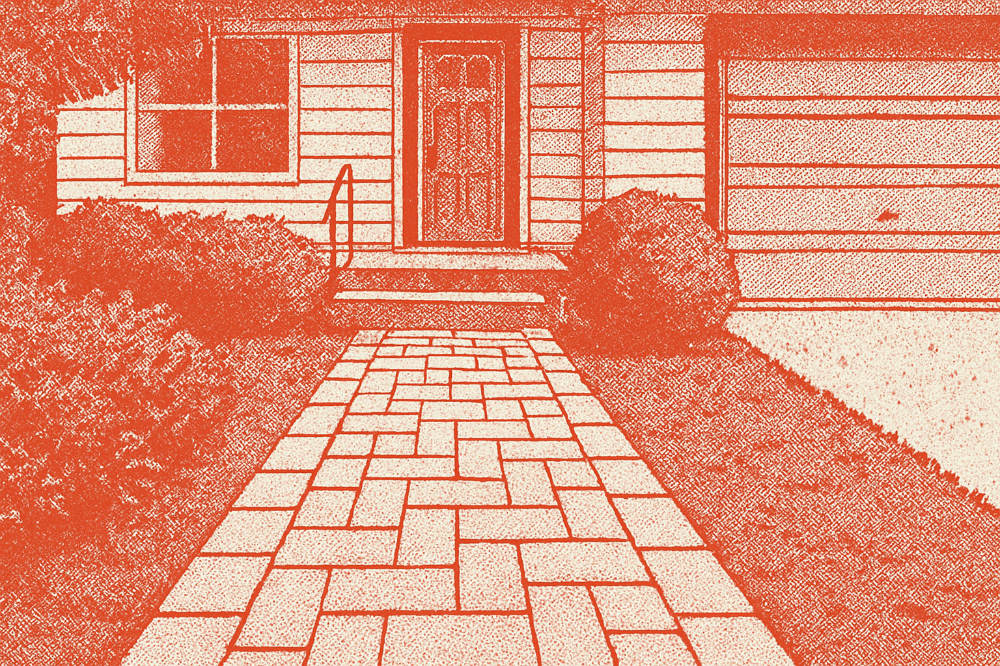Walkway Materials

We can build a walkway using whatever material you want, but most of our customers choose concrete pavers. They tend to offer a good balance of price, durability, and appearance. That said, we also build walkways from limestone slabs or stepping-stone-style paths using slate or other natural stone.
Why choose pavers?
Concrete pavers are manufactured to consistent dimensions and shapes, which makes them relatively easy to install with tight joints and clean lines. Because they interlock and sit on a compacted gravel base, they can shift slightly without cracking – this flexibility is important in places like Winnipeg, where the ground freezes and thaws repeatedly throughout the year.
If one paver cracks or stains, it can be removed and replaced without disturbing the rest of the path. This kind of modular repair is not possible with poured concrete or many natural stones.
Most pavers have enough surface texture to provide grip in winter, and they can be shoveled or snow-blown without much risk of damage.
Natural stone options
Natural stone is more expensive than pavers – not because it's inherently better, but because it's heavier, varies in shape and thickness, and usually takes longer to install well. It also tends to come from further away and often requires more time to sort and lay out in a visually pleasing way.
Limestone
Limestone slabs are locally available and often contain visible fossils from the ancient Lake Agassiz seabed, which can make them visually striking. However, limestone is a relatively soft sedimentary rock, so slabs may crack, chip, or begin to crumble at the edges over time, especially under frequent foot traffic or freeze-thaw stress.
Flagstone (slate or similar)
Flagstone from northern Manitoba and Ontario is harder and often has richer color variation and texture than limestone. It’s well-suited for feature areas where people walk occasionally, but not ideal for paths that are used every day or need to be shoveled – irregular surfaces, thin edges, and shifting over time can all become problems if the base isn't perfect or if the stones are exposed to repeated mechanical force (like a snow shovel catching on a corner).
Informal walkways
If concrete pavers or natural stone slabs are beyond your budget, you might consider a crushed stone or wood mulch walkway.
In an informal garden setting a wood mulch pathway can provide clean, dry access to a potentially muddy area of your yard. Crushed stone pathways can be a very economical alternative to a paved surface. While not ideal as a main walkway that gets used multiple times per day, it may be an practical solution to a longer walkway that wraps around the side of your house.
If prepared properly, it could be converted to pavers or slabs at some point in the future.
Longevity
The lifespan of any walkway is determined more by what’s underneath than what’s on top. All materials – pavers or stone – need a base made of well-compacted gravel with a layer of bedding sand (or mortar for some stone installations). This base prevents the walkway from settling unevenly over time.
Natural stone is less forgiving of imperfect bases. If the base settles or heaves even slightly, you'll notice it right away. With pavers, a small amount of movement is absorbed by the sand joints.
Winter considerations
For walkways that need to be cleared in winter, smooth, flat surfaces with tight joints are less likely to catch a shovel or the edge of a snowblower. Concrete pavers are best for this purpose. We know what works here because we actually do professional snow clearing in the winter.
Cost and repair
Pavers usually cost less per square foot than natural stone, not just because of the material cost, but because the installation is faster and more predictable. Natural stone paths take longer to build because the installer must select, level, and fit each piece by hand. If a stone breaks later, it's much harder to replace without disturbing the rest of the walkway.
Design flexibility
Pavers come in a wide range of colors, shapes, and patterns. This doesn’t make them better – it just gives you more control over the final look. Natural stone, on the other hand, has an irregular shape and color, which gives it a more organic feel. If you want a pathway that looks like it was always part of the landscape, natural stone can be a good choice. If you want precise geometry or repeating patterns, pavers are the better fit.
How to decide
Let us help! Send us an email to discuss your project, with no obligation whatsoever.



